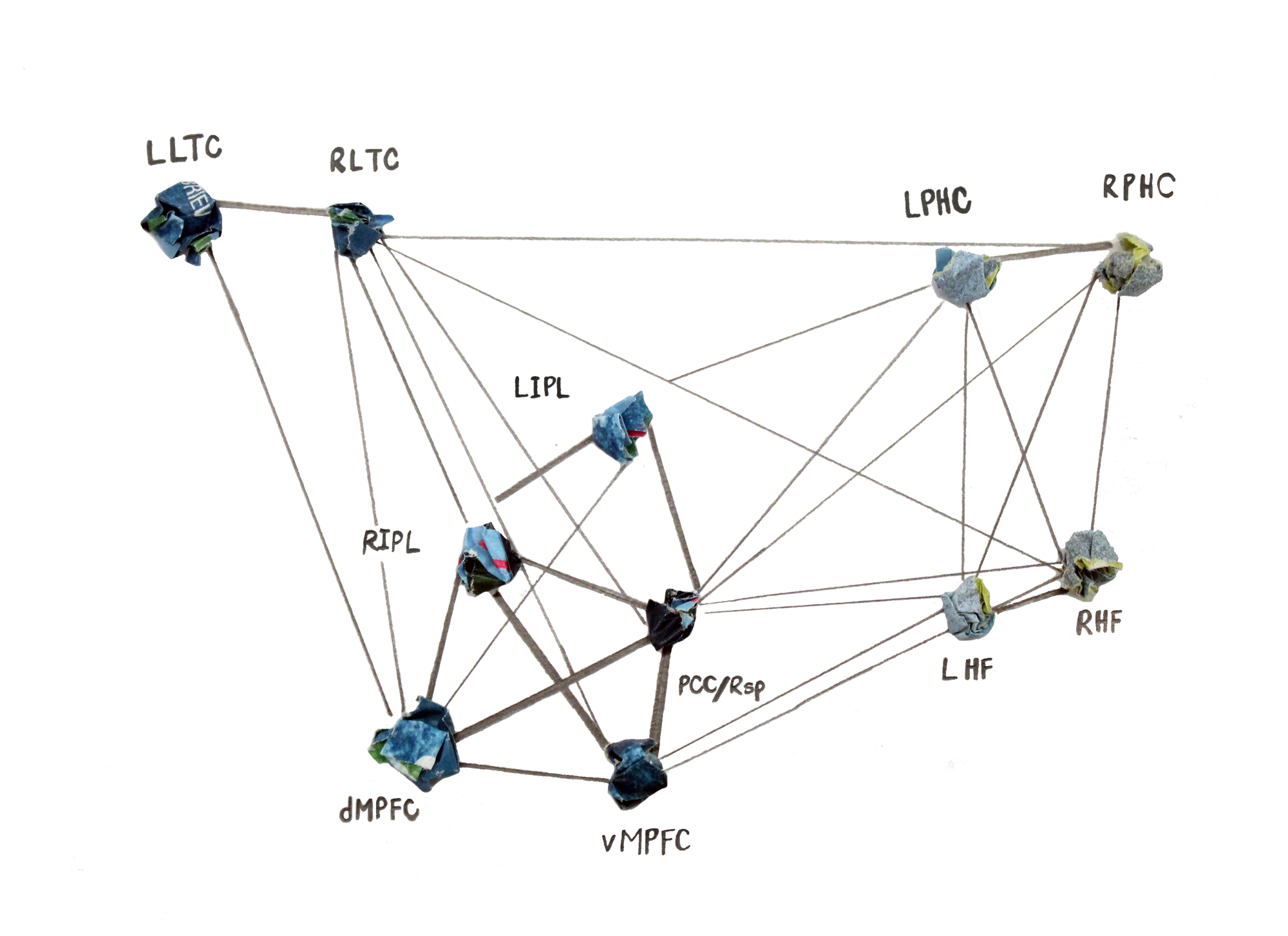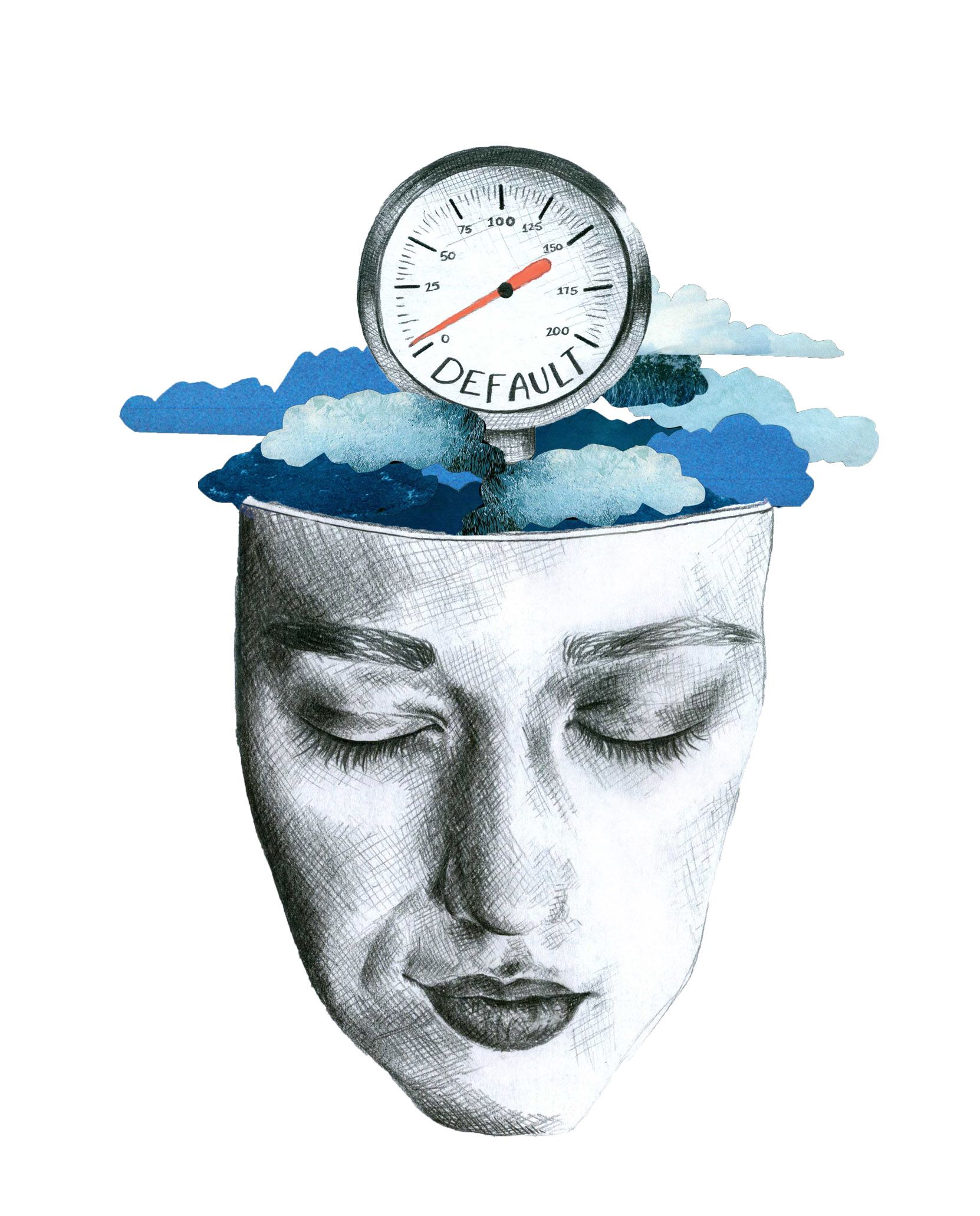It seems intuitive that the brain is active when one is engaged in tasks like studying, and less active when taking a break. But what actually happens in the brain when we aren’t focused on anything external? Contrary to intuition, research reports that the difference in energy consumed by the brain when thinking to oneself versus active engagement with the environment is small—an insignificant decrease of less than 5% [1]. These findings led researchers to propose the existence of a neural system that consumes energy and is only dominant when we are not focused on the external environment. Essentially, this neural system is active when one feels like they are not doing anything. As such, one can think about the pattern of activity in this system as being the default neural state of your brain, independent of the external environment. The system that regulates this state is thus known as the “default mode network.”
The central idea behind the default mode network (DMN) is straightforward: it is a set of interconnected brain regions whose activity is associated with introspection (the examination or observation of one's own mental and emotional processes) and other internally-directed cognitive behaviors. The DMN has two important characteristics: the network increases energy consumption during internally-directed cognitive states, and decreases energy consumption during external, goal-directed behaviors. These metabolic characteristics distinguish the DMN from other brain networks, which generally consume more energy during external behaviors and consume less during introspective behaviors. The DMN includes functional regions throughout the brain, from the frontal lobe to the hippocampus and beyond. Specifically, the DMN includes areas in the ventral medial prefrontal cortex, posterior cingulate and retrosplenial cortex, inferior parietal lobule, lateral temporal cortex, dorsal medial prefrontal cortex, and hippocampal formation (Figure 1) [1].


Surpisingly, neuroscientists have been unintentionally collecting data on the DMN for a long time. Traditionally, periods of internally-directed thinking, known as “rest states,” have been used as a comparison for many external tasks in neuroimaging experiments [1]. During these rest states, subjects are prompted to perform some form of internally-directed cognition. For example, a subject may be asked to think about the color purple or what they did the day before. The pattern of activity in these rest states can then be compared to the pattern of activity in a externally-directed task, like having a conversation or reaching for a pencil. The first person to find hints of what we now call the DMN was Hans Berger, using his newly invented electroencephalogram in 1929. Berger showed that the brain’s overall electrical activity is relatively constant even during these supposed “rest” states. Other researchers soon noticed that this characteristic rest state activity in the brain was “deactivated” during the performance of an external task—the areas that showed an increase in activity during the rest state promptly “deactivated” as soon as the person engaged in an external task [1].
Ultimately, the name “default mode network” was coined by Marcus Raichle from the Washington University School of Medicine. In a groundbreaking 2001 study, Raichle used positron emission tomography, a type of brain imaging, to show that when the brain is not focused on external stimuli, there is a “baseline” (or default) state of the brain that is remarkably consistent. Different forms of internally directed cognition produced the same type of activity in the same brain regions. Most importantly, the Raichle study demonstrated the suspension of this activity during goal-directed behavior, akin to what had previously been described as “deactivations” [2]. Overall, Raichle gave evidence that self-referential processes were a specific form of cognition regulated by their own neural circuitry—and thus, the DMN became a legitimate neural system.
In an attempt to better understand the DMN, researchers have examined exactly how this neural network functions. Similar to other neural systems, the structures of the DMN communicate with each other extensively due to a high degree of interconnectivity within the network [1]. Many of these structures also play other critical roles beyond the DMN, such as the hippocampus, which plays an important role in the formation of long-term memories. It is also important to note that the DMN does not work alone when maintaining a train of thought or internal cognition. The DMN instead likely works in tandem with many other large-scale brain systems to generate thought [3]. It has been particularly interesting to researchers to explore how the DMN interacts with another neuronal system known as the salience network. Evidence suggests that the salience network is responsible for detecting behaviorally significant stimuli in the external environment [3]. Because of this, interaction between the DMN and the salience network may be responsible for cognitive “toggling” between external perception and self-generated thought [3].
While this evidence clearly supports the existence of a DMN, its exact function is still unclear. Given the strong correlation of increased DMN activity during introspective cognition, many neuroscientists hypothesize that the network is involved in a multitude of internally-directed cognitive processes, such as daydreaming, future planning, memory retrieval, and most importantly, theory of mind [1]. However, most studies use a very simple (but standard) experimental model, in that they have study participants engage in task-positive and task-negative behaviors and compare the two sets of functional neuroimages, which are indicative of neural activity. Because of this, researchers have yet to establish a direct causal link between these cognitive behaviors and DMN activity, since almost all studies involving the DMN are correlational in nature.
To try to remedy this problem and examine whether there is a causal link between the DMN and introspection, a group of researchers at Washington University in St. Louis attempted to analyze the function of the DMN throughout development. The researchers used magnetic resonance imaging (MRI) to assess the functional connectivity between brain regions in the DMN during the “resting state.” If changes in the DMN connectivity were found to be associated with changes in introspective abilities (like memory retrieval) over time, then this would help to establish stronger evidence for a causal relationship between the DMN and its proposed functions. Through these experiments, the team revealed that the DMN regions were only sparsely functionally connected in 7-9 year olds [4]. In adulthood, however, these regions showed a significantly higher amount of functional connectivity as compared to the younger participants. [4]. This makes sense considering that children’s abilities to perform many of the behaviors attributed to the DMN improve with age, particularly episodic memory retrieval and theory of mind [4]. The researchers thus concluded that neural development might be associated with an improvement in the function of the DMN.
Regardless of its function, research seems to suggest that failing to develop a robust DMN may have negative implications. Deficiencies in the DMN have been observed in many brain disorders, including autism [1]. Among individuals with an autism spectrum disorder, the less the DMN is able to deactivate during task-oriented behavior, the higher the severity of autism symptoms [5]. A similar failure to deactivate is present in schizophrenia, along with an overall hyperconnectivity of the regions between the structures in the DMN [6]. This suggests that in schizophrenia the regions of the DMN may communicate too much, leading to an overwhelming amount of internal cognition, making it difficult for schizophrenic patients to distinguish between the external perceptions and self-generated thoughts. In those with Alzheimers’s disease, the neurons of the DMN appear to be disproportionately affected by plaque buildup when compared to other regions of the brain. These plaques lead to a reduction of neuronal activity in the DMN structures, and this is associated with [insert VERY brief description of behavioral symptoms of AD] [1]. Given these findings, it’s possible that a healthy DMN is critical to a healthy brain. But for those with dysfunctional DMNs, is there anything that can be done to improve the function of the DMN?

One study suggests that there may be—through meditation, a technique commonly associated with introspection. In a 2014 meta-analysis of long-term meditation practitioners, researchers observed structural changes in the DMN [7]. The study also found significantly reduced activity in the DMN during rest states and an overall reduced connectivity of the DMN structures: nearly the polar opposite of what has been observed in patients with autism and schizophrenia. Though this is not to say that a DMN with less connectivity is always correlated with an increase in function, as the opposite result was found in the studies with children discussed earlier. Instead, there appears to be an optimal amount of connectivity to maximize the function of the DMN, as both hypoconnectivity and hyperconnectivity lead to a decrease in DMN function. This is logical, considering other researchers have pointed out that self-generated cognition and introspective thought can be both adaptive and maladaptive, depending on environmental circumstances [2]. Overall, this evidence primarily suggests that the development of the DMN can be altered by behavior in a way that may increase the functionality of the system, similar to many other neuronal structures.
The DMN is much more than your brain at rest. While we still aren’t sure exactly what it does or how, the DMN is a fascinating system that many believe plays a role in a variety of cognitive processes. Regardless of its function, it was only thirty years ago that the existence of the DMN itself was nothing more than a fantastical hypothesis. Today, however, evidence suggests that it may play a large role in our cognitive existence. Further study will hopefully continue to unlock secrets of the brain when it is simply running on default.
References
- Buckner, R., Andrews-Hanna, J., & Schacter, D. (2008). The Brain's Default Network: Anatomy, Function, and Relevance to Disease. Annals of the New York Academy of Sciences, 1124, 1-38.
- Raichle, M., et al. (2001). A default mode of brain function. Proceedings of the National Academy of Sciences, 98, 2, 676-682.
- Andrews-Hanna, J., Smallwood, J., & Spreng, R. (2014). The default network and self-generated thought: Component processes, dynamic control, and clinical relevance. Ann. N.Y. Acad. Sci. Annals of the New York Academy of Sciences, 1316, 29-52.
- Fair, D., Cohen, et al. (2008). The maturing architecture of the brain's default network. Proceedings of the National Academy of Sciences, 105, 10, 4028-4032.
- Kennedy, D., Redcay, E., & Courchesne, E. (2006). Failing to deactivate: Resting functional abnormalities in autism. Proceedings of the National Academy of Sciences, 103, 21, 8275-8280.
- Whitfield-Gabrieli et al.. (2009). Hyperactivity and hyperconnectivity of the default network in schizophrenia and in first-degree relatives of persons with schizophrenia. Proceedings of the National Academy of Sciences, 106, 4, 1279-1284.
- Fox, K. et al. (2014). Is meditation associated with altered brain structure? A systematic review and meta-analysis of morphometric neuroimaging in meditation practitioners. Neuroscience & Biobehavioral Reviews, 43, 48-73.
